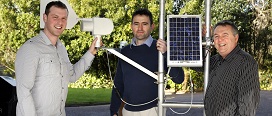2013 Press Releases
UCC research could help allergy sufferers

UCC scientists have completed a major study on air quality using a novel air monitoring approach which has been published by the Environmental Protection Agency (EPA).
Professor John Sodeau and his research team at the Centre for Research Atmospheric Chemistry (CRAC) in UCC used state-of-the-art air quality instrumentation to detect and quantify pollen, fungal spores and bacteria that are all components of the air we breathe and are known as bio-aerosols.
Professor Sodeau, principal investigator on the project said: “Many airborne biological particles are known to impact adversely on our health. Pollen, fungal spores and certain bacteria are often culprits in symptoms presenting in persons sensitive to hay fever or respiratory diseases including asthma. Ireland currently makes no pollen count measurements of its own but our near real-time approach could make this task considerably easier.”
Dr David Healy, lead researcher and author on the BioCheA project alongside EPA Doctoral student David O’Connor found that there were more bioaerosols in the air monitored at Killarney National Park than in urban and industrial environments during the summer. While a higher number of bio-aerosol particles would be expected in a rural setting, the research team field tested technology that allowed their detection and quantification in near real-time. Recent research findings also indicate that bioaerosols may have a more important role than previously thought in influencing climate and global hydrological cycles. Therefore this method of monitoring could allow agencies to warn people who are susceptible to respiratory disease and inform responses.
Key elements of the report include:
- Ireland currently makes no pollen count measurements of its own but this real-time approach could make the task considerably easier.
- The instrumentation used in this research to detect bio-aerosols (such as pollen, fungal spores and hyphal fragments) can be employed routinely and reliably in the laboratory and field.
- In terms of the different types of spores in the air, the field results confirm the large range of types expected to be found in the air in North-West Europe during the sample time periods.
- The approach to bioaerosol measurement coupled with the novel methods of data analysis could be employed in a number of different settings both outdoors (e.g. compost/waste facilities) and indoors (e.g. hospitals).
Commenting on the release of the research report Dara Lynott EPA Director said: “The environment and health are intrinsically linked and this innovative research project shows how state of the art instrumentation can be used to help protect both. The novel application of technology could help people who suffer from respiratory issues to avoid problems by knowing what is in the air and thereby minimizing airborne infections.”
This research was conducted in the Centre for Research Atmospheric Chemistry (CRAC) in UCC and was funded by the EPA’s Climate Change Research Programme. The full report, A new approach to Bioaerosol Monitoring in Ireland, is now available on the EPA website at www.epa.ie/downloads/pubs/research/climate/
